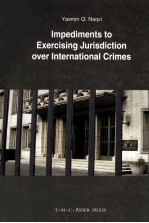

IMPEDIMENTS TO EXERCISING JURISDICTION OVER INTERNATIONAL CRIMESPDF电子书下载
- 电子书积分:14 积分如何计算积分?
- 作 者:YASMIN Q.NAQVI
- 出 版 社:T.M.C.ASSER PRESS
- 出版年份:2010
- ISBN:9067043206
- 页数:418 页
Part One Exercising Jurisdiction over International Crimes 3
Chapter 1 INTRODUCTION 3
1.1 Impediments to exercising jurisdiction over international crimes 9
1.2 Impediments 11
1.3 Jurisdiction 13
1.4 International crimes 21
1.4.1 War crimes 32
1.4.1.1 Grave breaches 32
1.4.1.2 Serious violations of the laws and customs of war 34
1.4.2 Crimes against humanity 37
1.4.3 Genocide 49
1.4.4 Torture 59
Part Two Impediments 75
Chapter 2 AMNESTIES 75
2.1 Definition and historical context 75
2.2 Amnesties and international and hybrid criminal courts and tribunals 85
2.3 Contextual and policy considerations 93
2.3.1 The need to secure the peace and maintain the peace 95
2.3.2 The need for a public accounting of the truth 98
2.3.3 The need to strengthen the rule of law and uphold the principle of legality 102
2.3.4 The question of deterrence 103
2.3.5 The need for reconciliation 106
2.4 Legal rationales with regard to the exercise of jurisdiction in the face of amnesties 110
2.4.1 The scope of the obligation to prosecute international crimes 110
2.4.2 Whether victims’fundamental rights vitiate the validity of amnesty laws 124
2.4.3 Whether States are constrained not to amnesty international crimes due to the peremptory character of international crimes 138
2.5 Preliminary conclusions 144
Chapter 3 PARDONS 149
3.1 Definition and historical background 150
3.2 Pardons and international and hybrid criminal courts and tribunals 154
3.3 Contextual and policy considerations 155
3.4 Legal rationales with regard to the use of pardons covering international crimes 161
3.4.1 The scope of the obligation to punish those convicted of international crimes 163
3.4.2 The possibility of pardons or commutation of sentence by international criminal courts 171
3.4.3 Clemency by way of the guilty plea 175
3.4.4 The possible ne bis in idem effect of pardon 177
3.5 Preliminary conclusions 181
Chapter 4 STATUTES OF LIMITATION 183
4.1 Definition and historical background 184
4.2 Statutes of limitation and international and hybrid criminal courts and tribunals 188
4.3 Contextual and policy considerations 190
4.4 Legal rationales with regard to statutes of limitation covering international crimes 192
4.4.1 International customary law precludes the use of statutes of limitation over international crimes 192
4.4.2 Obligations to prosecute international crimes or to ensure fundamental human rights are incompatible with statutes of limitation 209
4.4.3 The purposes and principles underlying the use of statutes of limitation do not account for the specificities of cases dealing with international crimes 211
4.4.4 Time may be tolled in many cases where international crimes have been committed 214
4.5 Preliminary conclusions 217
Chapter 5 IMMUNITIES 221
5.1 Definition and historical background 222
5.1.1 Functional immunity 223
5.1.2 Act of State doctrine 226
5.1.3 Personal immunity 228
5.1.3.1 Diplomatic immunity 229
5.1.3.2 Head of State Immunity 230
5.1.3.3 Head of government and foreign minister immunity 233
5.1.4 State immunity 236
5.1.5 National immunity 240
5.2 Immunities and international and hybrid criminal courts and tribunals 243
5.3 Contextual and policy considerations 246
5.3.1 Functional immunity 246
5.3.2 Act of State doctrine 248
5.3.3 Personal immunity 249
5.3.3.1 Diplomatic immunity 249
5.3.3.2 Head of State immunity 249
5.3.3.3 Head of Government and Foreign Minister immunity 250
5.3.4 State immunity 251
5.3.5 National immunity 253
5.4 Legal rationales with regard to functional and personal immunities for international crimes 253
5.4.1 Treaty obligations to prosecute or extradite persons accused of international crimes are incompatible with immunities 254
5.4.2 States have impliedly waived immunity of their officials by signing treaties criminalising certain international offences 258
5.4.3 Customary international law lifts functional (and personal) immunityin case of international crimes 262
5.4.4 The jus cogens nature of international crimes overrides immunity 268
5.4.5 International crimes fall outside of the notion of ‘acts performed in a sovereign capacity’ 277
5.4. The fundamental rights of victims are incompatible with fundamental human rights 281
5.5 Preliminary conclusions 284
Chapter 6 THE PRINCIPLE OF NE BIS IN IDEM 287
6.1 Definition and historical background 288
6.1.1 Historical background 288
6.1.2 Ne bis in idem and international and hybrid criminal courts and tribunals 290
6.1.3 Definition 292
6.1.3.1 What constitutes an ‘idem’ 295
6.1.3.2 Types of procedures to which ne bis in idem may attach 300
6.2 Contextual and policy considerations 306
6.3 Legal rationales with regard to the principle of ne bis in idem and international crimes 310
6.3.1 Legal arguments countering a transnational ne bis in idem principle 310
6.3.2 Fundamental defects in the trial/Sham trial 315
6.3.3 Retrial in the case of newly discovered evidence or facts 318
6.3.4 The State claim to exercise jurisdiction over offences committed on its territory 322
6.3.5 Exception for certain offences 323
6.3 Additional serious offences 323
6.4 Preliminary conclusions 325
Chapter 7 ABUSE OF PROCESS 329
7.1 Definition and historical background 330
7.2 Contextual and policy considerations 332
7.2.1 The need to ensure a fair trial 332
7.2.2 The need to preserve the integrity of the judicial system 333
7.3 Legal rationales with regard to the doctrine of abuse of process and international crimes 336
7.3.1 Abduction/Disguised extradition 336
7.3.1.1 National level 336
7.3.1.2 International level 341
7.3.2 Procedural rights 347
7.3.2.1 National level 348
7.3.2.2 International level 348
7.3.3 Delay 352
7.3.3.1 National level 352
7.3.3.2 International level 353
7.3.4 Withholding of exculpatory evidence 355
7.3.5 Double jeopardy 357
7.3.6Breach of promises of non-prosecution (amnesty) 357
7.3.6.1 National level 357
7.3.6.2 International level 358
7.3.7 Misuse of the criminal process 361
7.4 Preliminary conclusions 362
Part Three General Conclusion 367
Chapter 8 GENERAL CONCLUSION 367
Bibliography 381
Table of Cases 395
Index 413
- 《竞争战略 全译珍藏版》(美)迈克尔·波特(Michael E. Porter)著 2012
- 《网络互联技术手册 第2版》(美)(K.唐斯)Kevin Downes等著;包晓露等译 1999
- 《新版交换式以太网和快速型以太网 第2版》(美)(R.布雷耶)Robert Breyer,(美)(S.赖利)Sean Riley著;肖文贵等译 1997
- 《摄影100关键词》(英)克拉克著 2011
- 《守望百年 中英文对照爱情长诗》蔡丽双著;张智中译 2014
- 《环境政策概要》(英)卡罗琳·斯奈尔(Carolyn Snell)著;宋伟译 2017
- 《驼铃 中-英-波兰文对照诗集》蔡丽双著;张智中,(波兰)博古米娜·雅尼卡译 2015
- 《爱海情帆 中-英-罗马尼亚文对照爱情长诗》蔡丽双著;张智中,德拉戈斯·巴尔布译 2016
- 《准备,开始,哎哟》(美)弗兰·马努斯肯著;(美)黛安娜·帕尔米西若绘;魏亚西译 2014
- 《埋藏在后院》(美)盖尔·赫尔曼著;(美)杰里·斯马斯绘;筱舟译 2014
